Equally Safe strategy: draft CRWIA
Draft children's rights and wellbeing impact assessment (CRWIA) of Scotland's strategy for preventing and eradicating violence against women and girls.
draft Child Rights and Wellbeing Impact Assessment: Equally Safe Child Rights and Well-being Impact Assessment: Annex D
CRWIA front sheet |
|
|---|---|
Policy/measure A general description of the policy/measure |
Equally Safe, Scotland’s Strategy to prevent and eradicate violence against women and girls focuses on preventing violence from occurring, building the capability and capacity of services and ensuring a strong Justice response to supporting victims and tackling perpetrators. |
Initiating department The responsible team or division. If this is a cross-cutting policy, name the team that has overall responsibility |
The Violence against Women Team in the Equality Unit leads, working closely with the Violence against Women leads in Justice and Health Directorates. |
Policy aims What the policy or measure is trying to achieve; what are the expected outcomes |
Equally Safe aims to create a Scotland where all individuals are equally safe and respected, and where women and girls live free from all forms of violence and abuse and the attitudes which perpetuate it. The descriptor of women and girls explicitly includes children and young people of all genders as subject to harm through gender based violence. This aim will require long term economic, social and cultural change. The delivery plan sets out a 5 year plan of action with collaborative working with key partners across sectors. |
Timetable What is the time frame for a policy announcement/ consultation/ implementation? |
A delivery plan setting out actions for 2017-2021 was published on 24 November 2017. |
Date |
|
Signature |
|
CRWIA Stage 1 |
|---|
1. What aspects of the policy/measure will affect children and young people up to the age of 18? All actions within the delivery plan to tackle the different forms of violence and shift societal attitudes will impact on children and young people 0-18. |
2. What likely impact - direct or indirect - will the policy/measure have on children and young people? The policy impacts directly on children and young people as it seeks to reduce gendered violence which they may experience directly or be party to. |
3. Are there particular groups of children and young people who are more likely to be affected than others? Vulnerabilities of being subjected to gender based violence are higher for children and young people:
|
4. Who else have you involved in your deliberations? We have worked closely with the VaW Justice Team, the Health Directorate lead on Violence against Women and have also engaged closely with colleagues in Children and Families and an Expert Adviser on Children and Young People from the University of Edinburgh. We have engaged with children and young people with lived experience of gender based violence through the Voice Against Violence, Power Up Power Down and Everyday Heroes participation projects. We have worked closely with stakeholders providing support services for children and young people who have experienced gender based violence, including: Together Scotland, Scottish Women’s Aid, Barnardo’s, Rape Crisis Scotland, the Children and Young People’s Commissioner for Scotland, Children 1st, the Scottish Children’s Reporter Administration (SCRA), National Society for the Prevention of Cruelty to Children (NSPCC), Children in Scotland, LGBT Youth Scotland, Scottish Youth Parliament and Aberlour. |
5. Will this require a CRWIA? Yes. Although the policy is determined to have a broadly positive impact on children and young people, there may be unintended consequences of particular measures. A CRWIA also helps to broaden and deepen our understanding of issues around children and young people and gendered violence. |
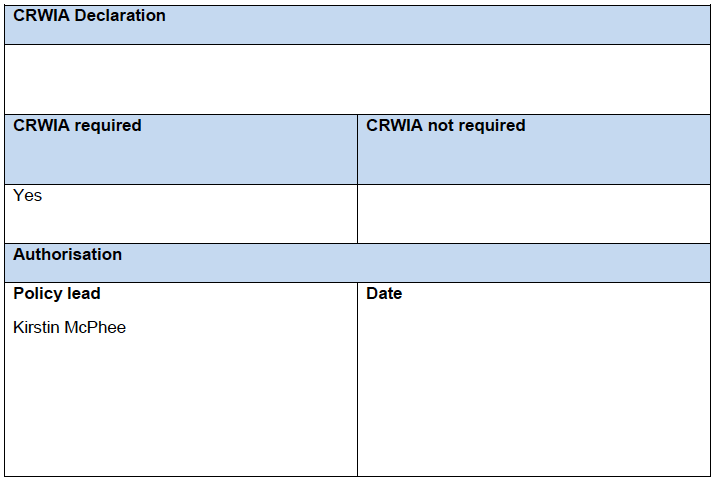
CRWIA Stage 2 |
|---|
1. What children’s rights are likely to be affected by the policy/measure? UNCRC articles ARTICLES: Article 2 (non-discrimination): The Convention applies to every child without discrimination, whatever their ethnicity, gender, religion, language, abilities or any other status, whatever they think or say, whatever their family background. Article 3 (best interests of the child): The best interests of the child must be a top priority in all decisions and actions that affect children. Article 4 (implementation of the Convention): Governments must do all they can to make sure every child can enjoy their rights by creating systems and passing laws that promote and protect children’s rights. Article 6 (life, survival and development): Every child has the right to life. Governments must do all they can to ensure that children survive and develop to their full potential. Article 14 (freedom of thought, belief and religion): Every child has the right to think and believe what they choose and also to practise their religion, as long as they are not stopping other people from enjoying their rights. Governments must respect the rights and responsibilities of parents to guide their child as they grow up. services for children and giving parents the help they need to raise their children. Article 19 (protection from violence, abuse and neglect): Governments must do all they can to ensure that children are protected from all forms of violence, abuse, neglect and bad treatment by their parents or anyone else who looks after them. Article 34 (sexual exploitation) : Governments must protect children from all forms of sexual abuse and exploitation. Article 35 (abduction, sale and trafficking): Governments must protect children from being abducted, sold or moved illegally to a different place in or outside their country for the purpose of exploitation. Article 39 (recovery from trauma and reintegration): Children who have experienced neglect, abuse, exploitation, torture or who are victims of war must receive special support to help them recover their health, dignity, self-respect and social life. Optional Protocol 2: The Optional Protocol on the sale of children, child prostitution and child pornography draws special attention to the criminalisation of these serious violations of children’s rights and emphasises the importance of increased public awareness and international cooperation in efforts to combat them. It supplements the Convention by providing States with detailed requirements to end the sexual exploitation and abuse of children and also protects children from being sold for non-sexual purposes – such as other forms of forced labour, illegal adoption and organ donation. The Protocol provides definitions for the offences of ‘sale of children’, ‘child prostitution’ and ‘child pornography’. It also creates obligations on governments to criminalise and punish activities related to those offences. It requires punishment not only for those offering or delivering children for the purposes of sexual exploitation, transfer of organs or children for profit or forced labour, but also for anyone accepting the child for these activities. The Protocol also protects the rights and interests of child victims. Governments must provide legal and other support services to child victims. This obligation includes considering the best interests of the child in any interactions with the criminal justice system. Children must also be supported with necessary medical, psychological, logistical and financial support to aid their rehabilitation and reintegration. As a complement to the Convention on the Rights of the Child, interpretation of the Optional Protocol’s text must always be guided by the principles of non-discrimination, best interests of the child and child participation. [https://www.unicef.org/crc/index_protocols.html] |
2. How will the policy/measure affect children’s wellbeing as defined by the wellbeing indicators? Section 96(2) of Children and Young People (Scotland) Act lists the eight wellbeing indicators, sometimes referred to by the acronym SHANARRI:
The Equally Safe delivery plan will impact across a range of children’s wellbeing indicators:
|
3. How many children and young people are likely to be affected by the policy or measure? The Under 18 population for Scotland as a total is 1,042,597 (19.68%). http://www.scotlandscensus.gov.uk/census-results Children and young people in every local authority will be impacted by these changes, though the impact will be greater for those experiencing gender based violence. A study by NHS Health Scotland (2005) of 1,395 young people between 14-18yrs found that a third of young men and a sixth of young women thought that using violence in an intimate relationship was acceptable under certain circumstances. It also found that 17 per cent of young women had experienced violence or abuse from a boyfriend. Being female is the key risk factor for experiencing abuse. However, not all women are equally at risk. Discrimination in relation to ethnicity, (dis)ability, sexual orientation, age, migrant or refugee status etc can increase and intensify the risk of abuse. Men and women who have experienced abuse may fear stigma, disbelief or ridicule following disclosure. Male survivors of childhood sexual abuse may additionally fear that they will be considered potential abusers. Although most survivors of abuse do not go on to abuse others, this assumption can be a very real barrier to disclosing. There are considerable overlaps in the nature, dynamics and impact of such abuse, for example, domestic abuse encompasses sexual violence, stalking, and forced marriage as well as physical and emotional abuse. Similarly, children who have been sexually abused in childhood may experience further victimisation in adulthood. Domestic abuse
Sexual violence The Scottish Crime and Justice Survey 2014/2015 found that since the age of 16 years, 13.5% of women and 2.7% of men had experienced some form of less serious sexual assault whilst 4.6% of women and 0.6% of men have experienced serious sexual assault or rape. 94.1% of the perpetrators of these sexual assaults were male; in 54.8% of cases victims were assaulted by their partner or ex-partner. Childhood sexual abuse (CSA) The World Health Organisation estimates that around 20% of girls and 5% of boys experience CSA. A UK report in 2005 found that 21% of girls and 11% of boys have experienced CSA. A UK wide study conducted by the NSPCC found that parents or guardians were perpetrators in 1.7% of cases of child sexual abuse reported. Young adult females reported the highest rate of sexual abuse from a parents or guardian, with 1.5% of females aged 18-24 reporting that this had happened in childhood. Commercial sexual exploitation A Home Office study (2004) found that 70% of women involved in street prostitution in the UK became involved as children or teenagers. 85% experienced physical abuse in their families, 45% experienced sexual abuse in their families. |
4. What research evidence is available? Preliminary identification of the research base for this policy/measure Equality and Human Rights Commission report 2009 “Responding to Gender Based Violence in Scotland: The Scope of the Gender Equality Duty to Drive Cultural and Practical Change” 2011 Census data Recommendations from CYP participation project Everyday Heroes Scottish Government Commissioned research: “Understanding Forced Marriage in Scotland” published January 2017 Susan Elsley “Children and young people’s experiences of, and views on, issues relating to the implementation of the United Nations Convention on the Rights of the Child” Early Intervention Foundation/Home Office commissioned research: “Child Sexual Exploitation: Understanding Risk and Vulnerability” 2016 Research in practice: “Working Effectively to Address Child Sexual Exploitation: An evidence scope” Barnardo’s “Unprotected, Overprotected: meeting the needs of young people with learning disabilities who experience, or are at risk of, sexual exploitation” 2016 State of Children’s Rights report by Together Scotland Recommendations from the Power Up Power Down review of the court ordered contact system Recommendations from the Voice Against Violence project on the experiences of eight children and young people who have experienced domestic abuse 89 responses to the public consultation on the draft delivery plan Evidence gained through discussion with stakeholders in the CYP Stakeholder Reference Group who represent affected children and young people and who deal directly with people affected by gender based violence. These discussions with people with specialist knowledge of affected communities has helped to provide first hand testimony with which to inform the evidence base. Evidence gained faced on the additional barriers faced by BME communities on gender based violence through discussions with specialist voluntary organisations such as Saheliya, Shakti Women’s Aid, Hemat Gryffe, the Amina Muslim Women Resource Centre and the Council of Ethnic Minority Voluntary Sector Organisations (CEMVO). 1.1.1 UN Convention on the Rights of the Child Concluding Observations made by the UN Committee on the Rights of the Child in 2016. Recommendations relevant to the CRWIA are highlighted below (in bold). 43. With reference to its general comment No. 13 (2011) and target 16.2 of the Sustainable Development Goals, the Committee recommends that the State party: (a) Revise the Children and Young Persons Act (1933) in order to protect all children under 18 years from child abuse and neglect; (b) Strengthen the systematic collection of data and recording of information on violence against children, including domestic violence, gender-based violence, abuse and neglect, in all settings, and the sharing of information and referral of cases among relevant sectors; (c) Increase the number of social workers and strengthen their capacity to address violence against children; (d) Give due weight to the views of children concerned in the responses to violence, including in criminal and family law proceedings; (e) Consider ratifying the Convention on preventing and combating violence against women and domestic violence 45. The Committee recommends that the State party, including devolved governments, overseas territories and Crown dependencies: (a) Systematically collect and publish comprehensive and disaggregated data on child exploitation and abuse, including through mandatory reporting, in all settings; (b) Develop and implement comprehensive multisectoral strategies on child exploitation and abuse, including online, to ensure effective prevention, early detection and intervention, at the national and devolved levels, in overseas territories and Crown dependencies; (c) Implement the recommendations of the Marshall Inquiry into child sexual exploitation in Northern Ireland; (d) Further develop comprehensive services to support children who are victims or at risk of sexual exploitation and abuse; (e) Strengthen the capacity of law enforcement authorities and the judiciary to detect and prosecute child sexual exploitation and abuse, and grant effective remedies to the child victims; (f) Consider ratifying the Council of Europe Convention on the Protection of Children against Sexual Exploitation and Sexual Abuse 47. With reference to its general comment No. 18 (2014) on harmful practices, the Committee recommends that the State party: (a) Take effective measures to ensure that marriage of children aged 16 and 17 years takes place only in exceptional circumstances and is based on the full, free and informed consent of the concerned children; (b) Continue and strengthen preventive and protection measures to address the issue of harmful practices, including the collection of data, the training of relevant professionals, awareness-raising programmes, the provision of protection and care to the child victims and the prosecution of those found guilty of perpetrating such acts; (c) Ensure that no one is subjected to unnecessary medical or surgical treatment during infancy or childhood, guarantee bodily integrity, autonomy and self determination to children concerned and provide families with intersex children with adequate counselling and support; (d) Provide redress to the victims of such treatment; (e) Educate medical and psychological professionals on the range of sexual, and related biological and physical diversity and on the consequences of unnecessary interventions for intersex children. General Comment No.13 on the Right of the Child to Freedom from all Forms of Violence provides further information on the implementation of UNCRC Article 19 (right to protection from violence). Particularly relevant is part 3 regarding the impact of violence of children and paragraph 72(b) regarding the gender dimensions of violence against children (see below). 72 (b) The gender dimensions of violence against children. Joint general recommendation No. 31 of the Committee on the Elimination of Discrimination against Women/General Comment No. 18 of the Committee on the Rights of the Child on harmful practices includes several recommendations including the following on how efforts to tackle harmful practices should be undertaken: 60. The Committees recommend that the States parties to the Conventions ensure that any efforts undertaken to tackle harmful practices and to challenge and change underlying social norms are holistic, community based and founded on a rights-based approach that includes the active participation of all relevant stakeholders, especially women and girls. |
5. Has there been any public or stakeholder consultations on the policy/measure? A public consultation on the Equally Safe draft delivery plan was held 23 March – 30 June 2017 with 79 responses received. The Equally Safe draft delivery plan has been drafted with regular consultation with a Children and Young People’s Stakeholder Reference Group with membership of Claire Houghton, Expert Adviser on Children and Young People to the Scottish Government, Engender, Children and Young Person’s Commissioner Scotland, ASSIST, Scottish Women’ Aid, Rape Crisis Scotland, Aberlour Child Care Trust, NSPCC, Barnados, Together Scotland, Children 1st, Children in Scotland, LGBT Youth Scotland, Scottish Children’s Reporter Administration (SCRA) and Scottish Youth Parliament. |
6. Has there been any estimate of the resource implications of the policy/measure? In March 2015, the First Minister announced that an additional £20m from Justice budgets would be allocated towards tackling violence against women. This money has already made a significant difference with direct support and assistance going to victims, as well as improvements being made to the system to prioritise court cases which involve domestic abuse so victims are not waiting for long periods for their trials to call. In June 2017, a further £11.8m was announced by the Equalities Secretary to support efforts to tackle violence against women and provide support for victims, bringing the total investment from the Equality Budget to almost £30 million over 2017 to 2020. |
CRWIA Stage 3 |
|---|
1. What does the evidence tell you? Everyday Heroes Recommendations CYP’s overarching priority was to Improve Education’s approach and response to Gender Equality and Gender Based Violence (GBV) 1. Education system to work alongside young people to address sex, consent and relationships, gendered norms in behaviour and subject choices, and gender inequality more widely, in tandem with efforts to promote all forms of diversity and equality. 2. Train all teachers on Gender Equality & GBV (Nursery-University, from qualification to CPD). 3. Improve Education’s responses to children and young people who have experienced gender based violence as a matter of urgency, in particular appropriate responses, information sharing and signposting young survivors to specialist services. 4. Tackle gender bias in schools, improve schools approaches to gender norms, stereotypes, roles, attitudes and ensure equal access to subjects, sport and space. 5. Embed Gender Equality & GBV Education in PSHE and Health and Well Being. Young Survivors’ Priority Actions for Services 1. Education, Police and Health professionals are trained in appropriate responses to children and young people experiencing gender based violence, as a matter of urgency. 2. Improve the accessibility of services to children and young people experiencing gender based violence. Improve information available to children and young people and professionals about these services. 3. Increase provision of welcoming, appropriate, well-resourced and supportive spaces within mainstream services and justice systems. 4. Increase children and young people’s access to supportive workers, specialist GBV services and advocacy. Young Survivor’s Priority Actions for the Justice System (criminal, civil, child protection) 1. The justice system needs to better implement children and young people’s right to have their views heard in matters affecting them, and for these views to be given due weight in decision-making. CYP feel they should have a say in who represents them and how. 2. Increase access to consistent, specialised support and advocacy workers throughout the justice process. 3. Improve information and communications processes for children and young people at every stage of the justice journey. 4. The criminal justice system needs to make practical improvements to reduce re-victimisation and trauma: CYP prioritise child-friendly and safer spaces and a reduction in waiting times for giving evidence (on the day as well as through the process). 5. There needs to be robust training for justice and education/community professionals in order to improve early intervention and justice responses to GBV. Young people’s priorities on Gender Inequality and Social Attitudes 1 Tackle gendered inequalities in gender, domestic and caring roles in relationships, homes, families and communities. 2 Increase diversity and reduce sexualisation, objectification, idealised representations of people and the influence of pornography in advertising, fashion and the media, including social media. 3 Reduce inequalities associated with gender and age in the workplace, and in routes to the workplace, including pay, status and occupation type.
4 Promote engagement of young people from all socio-economic backgrounds and communities in politics, and legal and political change. 5 Increase women’s access to and full representation in politics, including women from diverse ethnic and socioeconomic backgrounds. Young people’s priorities for participation in Equally Safe Policy 1. Involvement of CYP in national Equally Safe action including: dialogue between people in power and CYP on these priorities; CYP involvement in the monitoring of progress and involvement of CYP in each Delivery Plan action relevant to them. 2. Set up a National Youth Commission on Tackling Gender Inequality. 3. Set up a National Justice young survivors’ advisory group. 4. Action to ensure young people’s direct experience of services impacts on service development relevant to them: statutory/specialist service development, models of specialist/advocacy workers, reviews, evaluation and training. 5. Develop a national Gender Equality and Gender Based Violence Online Interactive Platform with CYP: clear information on services, rights, justice system; interactive support; signposting to specialist support; developing/promoting peer education models and creating empowering social media campaigns. |
2. What further data or evidence is required? There is generally a lack of information on the number of children affected by different forms of gender based violence in Scotland. |
3. Has there been any consultation on the development of the proposal(s)? The Equally Safe Delivery Plan has been developed in partnership and regular consultation with children and young people and the children’s workforce through:
|
4. Should children and young people be further involved in the development of this policy? Are there particular groups of children and young people whose views should be sought? An Experience Expert Panel has been created, building on the learning from our pilot participation projects to ensure that women, children and young people who have lived experience of gender based violence shape and influence implementation of the Equally Safe Delivery Plan. |
5. Should other stakeholders and experts be further involved in the development of this policy? The stakeholders previously part of the Children and Young People’s Stakeholder Reference Group will form part of a Stakeholder Advisory Forum, to harness the expertise of organisations and academics in this field and ensure that partners receive the best advice possible. Stakeholders as members of the Joint Strategic Board, will oversee strategic implementation of the Delivery Plan. |
CRWIA Stage 4 |
|---|
1. What likely impact will the policy have on children’s rights? Several actions in the delivery plan have the potential to have a particularly positive impact on children’s rights, such as actions relating to improving children’s voice in relation to contact and the implementation of recommendations from the review of court ordered contact, Power Up Power Down, and the action to establish as Safe and Together institute. Safe and Together recognises that abuse is a parenting choice, holds the abuser accountable for their actions and where possible makes arrangements to keep children with their non-abusing parent. Children’s rights organisations have noted that actions to raise awareness or on media portrayals of children and young people and gender based violence (GBV) that may negatively impact on children’s rights. If actions such as these do not consider the full range of forms of GBV and how these impact on children (e.g. if these actions do not cover child sexual abuse, or include how children experience domestic abuse with their mothers), then there is the potential that they will perpetuate public awareness of GBV that does not consider the impact on children and therefore could negatively impact on children’s rights. The action on considering the application of lessons from ‘Barnahus’ to apply in the Scottish context could have significant rights implications for children in Scotland in terms of their access to justice, the system not re-traumatising them and accessing recovery support early for the entire family. However, it is important that the changes are implemented and are applied consistently across Scotland in line with the PROMISE Standards otherwise it may be possible that implementation is patchy and some children have access to improved services and others do not. |
2 How will the policy/measure contribute to the wellbeing of children and young people? Provide any additional assessment using the wellbeing indicators framework. Indicators from the Equally Safe delivery plan:
|
3. Are some children and young people more likely to be affected than others? As raised in Together’s State of Children’s Rights report 2016, ‘many women and children who experience violence specifically because of their gender also face multiple discrimination across all protected characteristics, and also as a result of poverty and limited literacy skills.’. Further, although there is no evidence to suggest that there is a higher rate of gender-based violence within minority ethnic communities, there are specific cultural issues which can limit their access to support and protection. This can include: a lack of appropriate refuge space for women and children from BME communities, the role of other family members in perpetrating abuse and under-reporting caused by different cultural understandings of marital roles and issues such as stigma. Children and young people who live in families which experience domestic violence are also much more likely to be affected by the policies outlined in Equally Safe. Gyspy/Traveller children and young people and those living in rural areas will also face more barriers when accessing the services outlined in the delivery plan. |
4. Resource implications of policy modification or mitigation |
5. How does the policy/measure promote or impede the implementation of the UNCRC and other relevant human rights standards? This will inform Scottish Ministers’ duty to report to Parliament on children’s rights under the Children and Young People (Scotland) Act 2014. The Equally Safe Delivery Plan will promote the implementation of the UNCRC through regular consultation with children and young people on how the plan’s implementation will affect them through the Experience Expert Panel. The Plan as a whole will promote the implementation of the UNCRC by improving children and young people’s rights in Scotland as per the articles listed in 2.1 of this impact assessment. |
CRWIA Stage 5 |
|---|
1. Record your overall conclusions from the CRWIA The recommended actions in the Equally Safe Delivery Plan will directly impact on all children and young people experiencing gender based violence, and on frontline practitioners who support them. It will indirectly affect all members of society with increasing awareness raising measures being rolled out. |
2. Recommendations Having taken into account the outcome of this CRWIA from the outset, this has informed the development of the delivery plan. As a result of the data and evidence gathered, the Scottish Government continues to work with gender based violence survivors and practitioners to ensure that the plan is implemented with due consideration of the rights of children and young people. |
3. How will the policy/measure be monitored? Date and agreed process for monitoring and review The policy will be monitored over the next 4-5 years. The Equally Safe Delivery Plan governance structures – Joint Strategic Board, Joint Delivery Group, Stakeholders Forum and Experience Expert Panel – will all contribute to the monitoring of the plan’s implementation. Violence Against Women Partnerships will be responsible for collating information on the implementation of the Equally Safe Delivery Plan within each local authority. The Violence Against Women Team in the Scottish Government Equality Unit will have overarching responsibility for managing the monitoring process. The Joint Strategic Board, co-chaired by the Cabinet Secretary for Communities, Social Security and Equalities and the COSLA Spokesperson for Community Wellbeing will have final oversight of the monitoring of the implementation of the plan. |
4. Date and agreed process for Child Rights and Wellbeing Impact Evaluation The Child Rights and Wellbeing Impact Evaluation will work as a living document, updated alongside implementation of the Equally Safe Delivery Plan, and will be completed in 2021 as the Plan timeline ends. |
Final CRWIA - Web version of Policy CRWIA
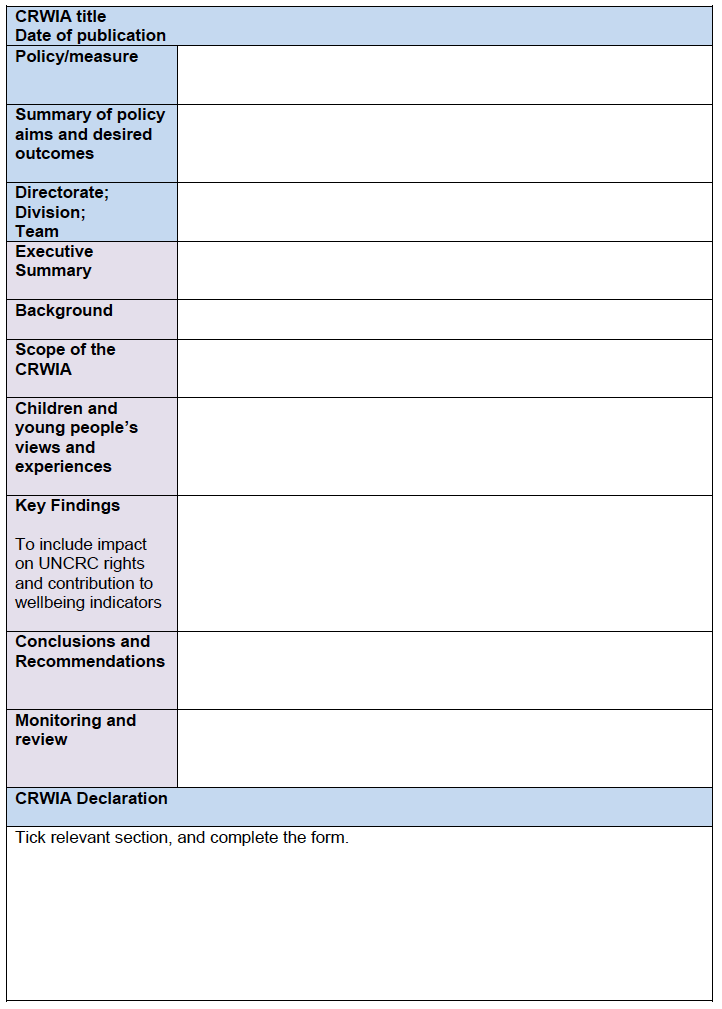
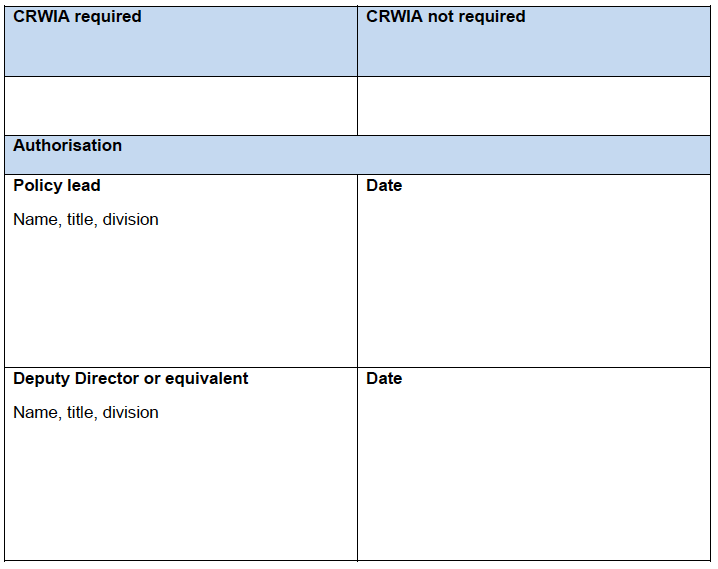
Final CRWIA - Web publication of Bill / Secondary Legislation CRWIA
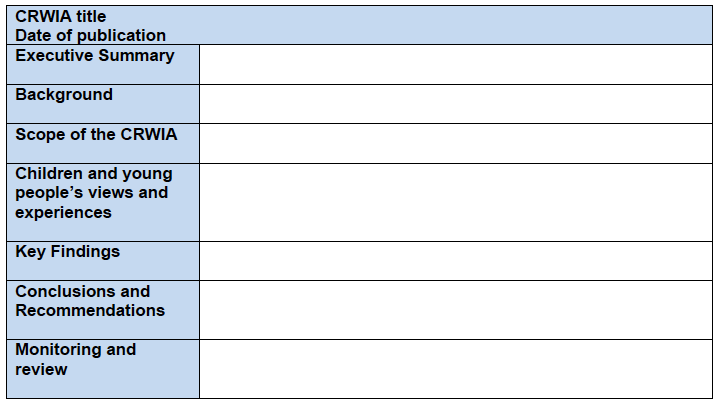
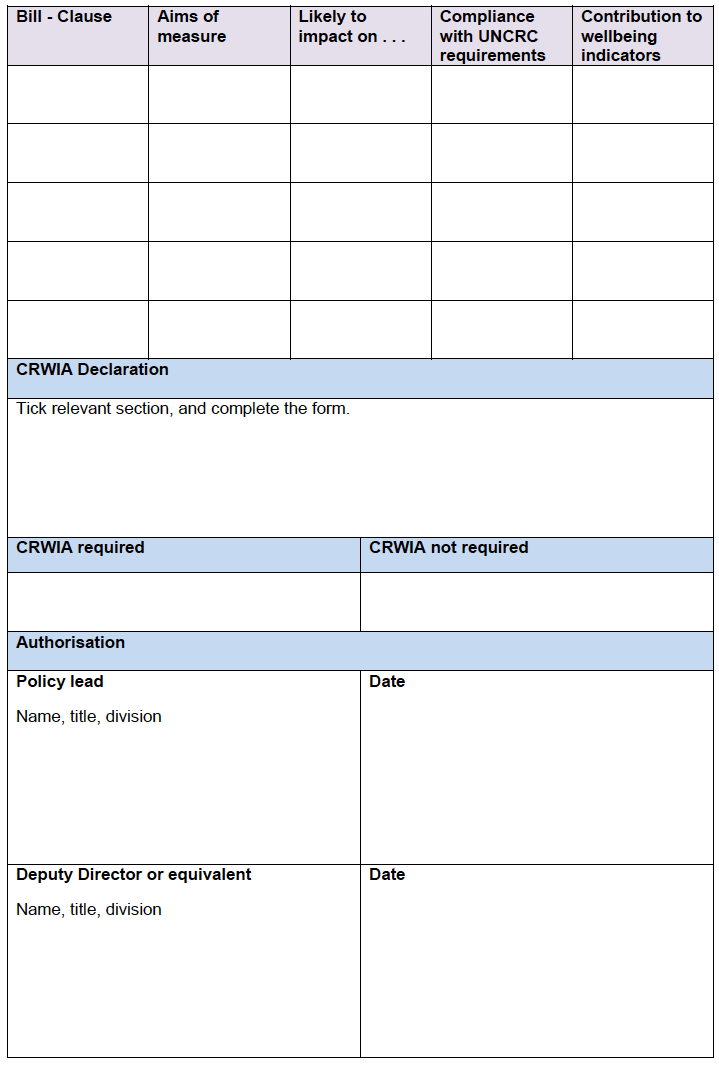
Contact
Email: Kirstin McPhee
There is a problem
Thanks for your feedback